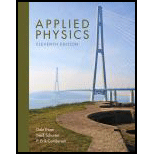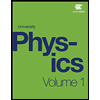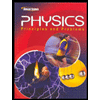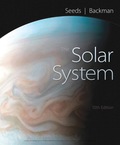
Applied Physics (11th Edition)
11th Edition
ISBN: 9780134159386
Author: Dale Ewen, Neill Schurter, Erik Gundersen
Publisher: PEARSON
expand_more
expand_more
format_list_bulleted
Concept explainers
Textbook Question
Chapter 5, Problem 10RQ
Distinguish between velocity and acceleration.
Expert Solution & Answer
Want to see the full answer?
Check out a sample textbook solution
Chapter 5 Solutions
Applied Physics (11th Edition)
Ch. 5.2 - Find the total force necessary to give each mass...Ch. 5.2 - Find the total force necessary to give each mass...Ch. 5.2 - Find the total force necessary to give each mass...Ch. 5.2 - Find the total force necessary to give each mass...Ch. 5.2 - Find the total force necessary to give each mass...Ch. 5.2 - Find the total force necessary to give each mass...Ch. 5.2 - Find the total force necessary to give each mass...Ch. 5.2 - Find the total force necessary to give each mass...Ch. 5.2 - Find the acceleration of each mass with the given...Ch. 5.2 - Find the acceleration of each mass with the given...
Ch. 5.2 - Find the acceleration of each mass with the given...Ch. 5.2 - Find the acceleration of each mass with the given...Ch. 5.2 - Find the acceleration of each mass with the given...Ch. 5.2 - Find the acceleration of each mass with the given...Ch. 5.2 - Find the acceleration of each mass with the given...Ch. 5.2 - Find the acceleration of each mass with the given...Ch. 5.2 - Find the acceleration of each mass with the given...Ch. 5.2 - Find the acceleration produced by a total force of...Ch. 5.2 - Find the total force necessary to give an...Ch. 5.2 - Find the total force necessary to give a rocket of...Ch. 5.2 - A forklift has a mass of 975 kg. What force must...Ch. 5.2 - A power wheelbarrow has a mass of 432 kg. What...Ch. 5.2 - What is the rate of deceleration of a 1400-kg SUV...Ch. 5.2 - An earthmover slows from 15.0 km/h to 3.00 km/h in...Ch. 5.2 - Find the total force necessary to give a 140-kg...Ch. 5.2 - Find the acceleration produced by a total force of...Ch. 5.2 - Find the mass of an object with acceleration 15.0...Ch. 5.2 - An automobile has a mass of 100 slugs. The...Ch. 5.2 - Find the acceleration produced by a force of 6.75 ...Ch. 5.2 - An astronaut has a mass of 80.0 kg. His space suit...Ch. 5.2 - A discus thrower exerts a force of 140 N on the...Ch. 5.2 - A scooter and rider together have a mass of 275...Ch. 5.2 - A pickup truck with mass of 1230 kg moving at 105...Ch. 5.3 - Find the weight for each mass. 1. m = 30. 0kgCh. 5.3 - Find the weight for each mass. 2. m = 60.0kgCh. 5.3 - Find the weight for mass. 3. m = 10.0 slugsCh. 5.3 - Find the weight for each mass. 4. m = 9.00 kgCh. 5.3 - Find the mass for each weight. 5. Fw = 17.0 NCh. 5.3 - Find the mass for each weight. 6. Fm = 21.0 lbCh. 5.3 - Find the mass for each weight. 7. Fw = 12,000 NCh. 5.3 - Find the mass for each weight. 8. Fw = 25, 000 NCh. 5.3 - Find the mass for the each weight. 9. Fw = 6.7 ...Ch. 5.3 - Find the mass for each weight. 10. Fw = 5.5 106...Ch. 5.3 - Find the weight of an 1150-kg automobile.Ch. 5.3 - Find the weight of an 81.5-slug automobile.Ch. 5.3 - Find the mass of a 2750-lb automobile.Ch. 5.3 - What is the mass of a 20,000-N truck?Ch. 5.3 - What is the mass of a 7500-N trailer?Ch. 5.3 - Find the mass of an 11,500-N automobile.Ch. 5.3 - Find the weight of a 1350-kg automobile (a) on the...Ch. 5.3 - Maria weighs 115 lb on the earth. What are her (a)...Ch. 5.3 - Johns mass is 65.0 kg on the earth. What are his...Ch. 5.3 - What is your weight in newtons and in pounds?Ch. 5.3 - What is your mass in kilograms and in slugs?Ch. 5.3 - What are your U.S. mass and weight on the moon?Ch. 5.3 - What are your metric mass and weight on the moon?Ch. 5.3 - Johns mass is 65.0 kg on the earth. What are his...Ch. 5.3 - Maria weighs 115 lb on the earth. What are her U...Ch. 5.3 - John's mass is 65.0 kg on the earth. What are his...Ch. 5.3 - What are your metric mass and weight on Jupiter,...Ch. 5.3 - What are your metric mass and weight on Mars,...Ch. 5.3 - An automobile transmission weighs 995 N. What is...Ch. 5.3 - A power wheelbarrow weighs 210 N. What is its...Ch. 5.4 - A cart on wheels weighs 2400 N. The coefficient of...Ch. 5.4 - A wooden crate weighs 780 lb. What force is needed...Ch. 5.4 - A piano weighs 4700 N. What force is needed to...Ch. 5.4 - A force of 850 N is needed to keep the piano in...Ch. 5.4 - A dog sled weighing 750 lb is pulled over level...Ch. 5.4 - A horizontal conveyor belt system has a...Ch. 5.4 - A tow truck can deliver 2500 lb of pulling force....Ch. 5.4 - A snowmobile is pulling a large sled across a...Ch. 5.4 - An automobile weighs 12,000 N and has a...Ch. 5.4 - A light truck weighs 14,000 N with a coefficient...Ch. 5.4 - A stake truck weighs 20,000 N with a coefficient...Ch. 5.4 - An alloy block is placed on a smooth composite...Ch. 5.4 - If a 20.0-N casting is placed on the block in...Ch. 5.4 - Rubber tires and wet blacktop have a coefficient...Ch. 5.4 - The coefficient of friction in Problem 15 is 0.700...Ch. 5.5 - Find the net force including its direction when...Ch. 5.5 - Find the net force including its direction when...Ch. 5.5 - Find the net force including its direction when...Ch. 5.5 - Find the net force including its direction when...Ch. 5.5 - Find the net force including its direction when...Ch. 5.5 - Find the net force including its direction when...Ch. 5.5 - Find the acceleration of an automobile of mass 100...Ch. 5.5 - Find the acceleration of an automobile of mass...Ch. 5.5 - A truck of mass 13,100 kg is acted upon by a...Ch. 5.5 - A speedboat of mass 30.0 slugs has a 300-lb force...Ch. 5.5 - A truck with a mass of 14,000 kg is pushed with a...Ch. 5.5 - A trailer has a mass of 5000 kg. It is pulled by a...Ch. 5.5 - A refrigeration unit on a job site must be slid...Ch. 5.5 - A light truck of 2000-kg mass has to be pushed...Ch. 5 - Force a. is a vector quantity. b. may be different...Ch. 5 - The metric weight of a 10-lb bag of sugar is...Ch. 5 - Mass and weight a. are the same. b. are different....Ch. 5 - According to Newtons second law, the law of...Ch. 5 - Friction a. always acts parallel to the surface of...Ch. 5 - Cite three examples of forces acting without...Ch. 5 - Using your own words, state Newton's first law,...Ch. 5 - Distinguish between velocity and acceleration.Ch. 5 - When the same force is applied to two different...Ch. 5 - Is 3 lb heavier than 10 N?Ch. 5 - Explain how life would be easier or more difficult...Ch. 5 - Explain how the weight of an astronaut is...Ch. 5 - Explain the difference between action and reaction...Ch. 5 - State Newton's third law of motion, the law of...Ch. 5 - A crate of mass 6.00 kg is moved by a force of...Ch. 5 - An 825-N force is required to pedal a bike with an...Ch. 5 - A block of mass 0.89 slug moves with a force of...Ch. 5 - What is the force necessary for a 2400-kg truck to...Ch. 5 - Two movers push a piano across a frictionless...Ch. 5 - A 340-N box has a frictional force of 57 N. Find...Ch. 5 - A truck pulls a trailer with a frictional force of...Ch. 5 - A steel box is slid along a steel surface. It has...Ch. 5 - A rock of a mass 13.0 kg is dropped from a cliff....Ch. 5 - A projectile has a mass of 0 37 slug. Find its...Ch. 5 - What force is required to produce an acceleration...Ch. 5 - Find the total force necessary to give a 280-kg...Ch. 5 - A force of 175 N is needed to keep a 640 -N...Ch. 5 - A crated garden tractor weighs 375 N. What force...Ch. 5 - Find the acceleration of a forklift of mass 1400...Ch. 5 - What is the weight of a 375-kg air compressor?Ch. 5 - What is the mass of a 405-N welder?Ch. 5 - What is the mass of a 12.0-N hammer?Ch. 5 - Engineers at Boeing developing specs for their...Ch. 5 - The Apollo spacecrafts were launched toward the...Ch. 5 - Kirsten's mass is 373 slugs. Being the physics fan...Ch. 5 - A motorcycle racer travelling at 145 km/h loses...Ch. 5 - The motorcycle and rider are sliding with the same...
Additional Science Textbook Solutions
Find more solutions based on key concepts
Find the frequency range of visible light, given that it encompasses wavelengths from 380 to 760 nm.
University Physics Volume 2
How far above the Earth’s surface will the acceleration of gravity be half what it is at the surface?
Physics for Scientists and Engineers with Modern Physics
A 54-kg ice skater pushes off the wall of the rink, giving herself an initial speed of 3.2 m/s. She then coasts...
Essential University Physics: Volume 1 (3rd Edition)
In a common physics demonstration, a bowling ball is suspended from the ceiling by a rope. The professor pulls ...
University Physics Volume 1
38. You want to produce a magnetic field of magnitude 5.50 × 10−4 T at a distance of 0.040 m from a long, strai...
College Physics (10th Edition)
If you increase the slit separation in a two-slit system, do the interference fringes become (a) closer togethe...
Essential University Physics (3rd Edition)
Knowledge Booster
Learn more about
Need a deep-dive on the concept behind this application? Look no further. Learn more about this topic, physics and related others by exploring similar questions and additional content below.Similar questions
- Are members of the highway patrol more interested in (a) your average speed or (b) your instantaneous speed as you drive?arrow_forwardThe distance traveled by a dropped object increases with ___. (2.3)arrow_forwardWhich is true about the acceleration due to gravity? (3.5) (a) It is a universal constant. (b) It is a fundamental property. (c) It decreases with increasing altitude. (d) It is different for different objects in free fall.arrow_forward
- A hot-air balloon rises from ground level at a constant velocity of 3.0 m/s. One minute after liftoff, a sandbag is dropped accidentally from the balloon. Calculate (a) the time it takes for the sandbag to reach the ground and (b) the velocity of the sandbag when it hits the ground.arrow_forwardAn astronomy textbook is to be dropped from a tall building on Earth. One second after dropped, what are the textbook’s speed, velocity, and acceleration? After 2 seconds? After 3 seconds? The book hits the ground; what are the book’s speed, velocity, and acceleration?arrow_forwardDoes the speedometer of a car measure speed or velocity?arrow_forward
- If a small lead ball falls from a high tower on Earth, what will be its velocity after 2 seconds? After 4 seconds?arrow_forwardBetween two points, which may be greater in magnitude, distance or displacement?arrow_forwardWhat area of physics involves the study of objects moving at relatively low speeds?arrow_forward
- The hat of a jogger running at constant velocity falls off the back of his head. Draw a sketch showing the path of the hat in the jogger’s frame of reference. Draw its path as viewed by a stationary observer. Neglect air resistance.arrow_forwardAcceleration may result from what? (2.3) (a) an increase in speed (b) a decrease in speed (c) a change in direction (d) all of the precedingarrow_forwardNeglecting air resistance, why would a ball projected horizontally and another ball dropped at the same time from the same initial height hit the ground together?arrow_forward
arrow_back_ios
SEE MORE QUESTIONS
arrow_forward_ios
Recommended textbooks for you
 University Physics Volume 1PhysicsISBN:9781938168277Author:William Moebs, Samuel J. Ling, Jeff SannyPublisher:OpenStax - Rice University
University Physics Volume 1PhysicsISBN:9781938168277Author:William Moebs, Samuel J. Ling, Jeff SannyPublisher:OpenStax - Rice University Glencoe Physics: Principles and Problems, Student...PhysicsISBN:9780078807213Author:Paul W. ZitzewitzPublisher:Glencoe/McGraw-Hill
Glencoe Physics: Principles and Problems, Student...PhysicsISBN:9780078807213Author:Paul W. ZitzewitzPublisher:Glencoe/McGraw-Hill An Introduction to Physical SciencePhysicsISBN:9781305079137Author:James Shipman, Jerry D. Wilson, Charles A. Higgins, Omar TorresPublisher:Cengage Learning
An Introduction to Physical SciencePhysicsISBN:9781305079137Author:James Shipman, Jerry D. Wilson, Charles A. Higgins, Omar TorresPublisher:Cengage Learning Foundations of Astronomy (MindTap Course List)PhysicsISBN:9781337399920Author:Michael A. Seeds, Dana BackmanPublisher:Cengage Learning
Foundations of Astronomy (MindTap Course List)PhysicsISBN:9781337399920Author:Michael A. Seeds, Dana BackmanPublisher:Cengage Learning Stars and Galaxies (MindTap Course List)PhysicsISBN:9781337399944Author:Michael A. SeedsPublisher:Cengage Learning
Stars and Galaxies (MindTap Course List)PhysicsISBN:9781337399944Author:Michael A. SeedsPublisher:Cengage Learning

University Physics Volume 1
Physics
ISBN:9781938168277
Author:William Moebs, Samuel J. Ling, Jeff Sanny
Publisher:OpenStax - Rice University

Glencoe Physics: Principles and Problems, Student...
Physics
ISBN:9780078807213
Author:Paul W. Zitzewitz
Publisher:Glencoe/McGraw-Hill

An Introduction to Physical Science
Physics
ISBN:9781305079137
Author:James Shipman, Jerry D. Wilson, Charles A. Higgins, Omar Torres
Publisher:Cengage Learning

Foundations of Astronomy (MindTap Course List)
Physics
ISBN:9781337399920
Author:Michael A. Seeds, Dana Backman
Publisher:Cengage Learning

Stars and Galaxies (MindTap Course List)
Physics
ISBN:9781337399944
Author:Michael A. Seeds
Publisher:Cengage Learning

Position/Velocity/Acceleration Part 1: Definitions; Author: Professor Dave explains;https://www.youtube.com/watch?v=4dCrkp8qgLU;License: Standard YouTube License, CC-BY